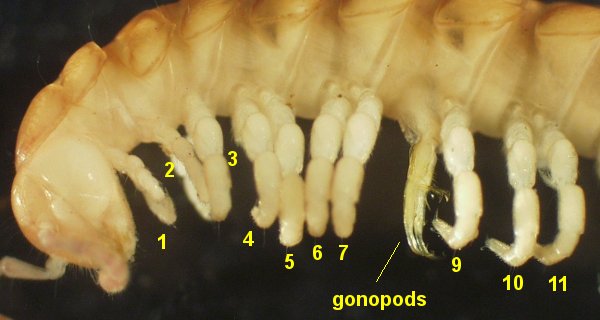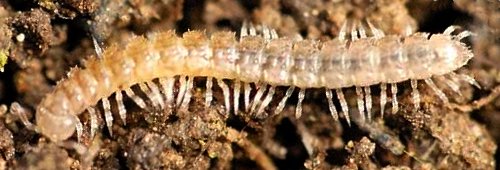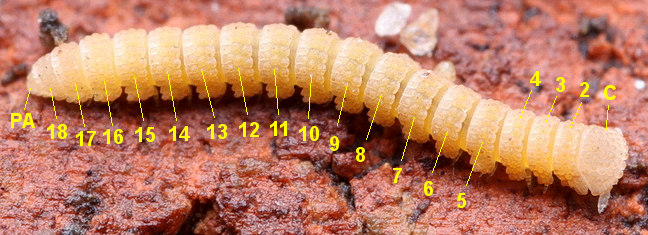Back to: anatomy terms
Forward to: growth
Body plan

The drawing above shows the main body components of an adult female polydesmidan with a head and 20 body rings (H+20). Below I'll explain the differences between adult males and females, and between H+20 and H+19, but this body plan is a good place to start. For body plans of juvenile Polydesmida, see the growth page.
The drawing shows the female from the left-hand side — that is, from the female's left-hand side. 'Left' and 'right' always refer to the millipede's left and right (see anatomy terms). For simplicity's sake, the drawing only shows the left-hand antenna and left-hand legs.
At the left end of the drawing is the head (H) with its antennae. Next is the plate-like collum (C). The collum is numbered as body ring 1, even though it is not a complete ring.
Immediately behind the collum is body ring 2, and below the collum and just ahead of 2 is a pair of legs. Behind body ring 2 are body rings 3 and 4, each with one pair of legs. Rings 2-4 are called haplosegments.
For more information on where the first pair of legs attaches, see the haplosegments page.
Next are 14 body rings (5-18) with two pairs of legs each. These rings are called diplosegments. Following the diplosegments is a single ring (19), sometimes called the apodous ring, which has no legs.
At the tail end of the millipede is the telson, which is made up of the preanal ring (PA) and the paraprocts and hypoproct, which close off the anus at the end of the digestive system. The telson as a whole is counted as the last segment in the body. (See the tail page for details.)
Note the leg count: an adult H+20 female has 62 legs (3 single pairs plus 14 double pairs), or 31 legs on each side.
Male vs female
In adult males, the first pair of legs on ring 7 is replaced by structures called gonopods, which are used to transfer sperm during mating. A gonopod is marked in red in the drawing below. Counting back from the head, the gonopods replace legpair 8. An adult H+20 male has two gonopods and 60 legs, which is two fewer legs than an adult H+20 female.

Legpair 1 is between the head (H) and ring 2 (first haplosegment),
legpair 2 is on ring 3 (second haplosegment),
legpair 3 is on ring 4 (third haplosegment),
legpairs 4 and 5 are on ring 5 (first diplosegment),
legpairs 6 and 7 are on ring 6 (second diplosegment),
legpairs 8 and 9 are on ring 7 (third diplosegment),
and so on.
Gonopods are often yellow-coloured and are usually very obvious on adult males:

Lissodesmus perporosus (Dalodesmidae), Tasmania
H+20 vs H+19

Adult H+19 Polydesmida (above) have 13 diplosegments instead of 14, but their body plan is otherwise the same as in H+20 species.
H+20: head + collum + 3 haplosegments + 14 diplosegments + apodous segment + telson
H+19: head + collum + 3 haplosegments + 13 diplosegments + apodous segment + telson
Adult H+19 females have 58 legs, and adult H+19 males have 56 legs.
There are many species of H+19 Polydesmida. They are generally smaller than H+20 Polydesmida and are not noticed as easily. One very common H+19 species in the temperate zone is Brachydesmus superus (shown below). This tiny millipede (<10 mm long) has been accidentally introduced into many countries and is common in parks and gardens. The picture shows an adult female from a meadow near Commanster in Belgium.
Count the legs on the left-hand side. Do you count 29?
Quick way to count: 3 singles + 13 doubles

Brachydesmus superus (Polydesmidae), Europe
Image © 2008 by J.K. Lindsey; used with permission
This very small H+19 species (image below) is from Singapore and is in the family Pyrgodesmidae. On a pyrgodesmid, the collum hides the head, and the paranota are placed low on the sides of the body and hide the legs.

Unidentified species of Pyrgodesmidae, Singapore
Image © 2011 by James Koh; used with permission
Exceptions
There are some (uncommon) exceptions to the patterns described above:
- Males of Aenigmopus alatus (Tridontomidae, Guatemala) have a normal legpair 8, and no gonopods at all
- In some species of Polydesmida, adult males are H+19 and adult females are H+20
- In a very few species, adults are H+18
- In the European cave-dwelling genus Devillea (Xystodesmidae), there are species up to H+28 in adult body plan
- The Brazilian cave species Dobrodesmus mirabilis has an H+40 body plan in adult males
For more details and a discussion of all millipede body plans, see Enghoff et al. (1993).
Enghoff, H., Dohle, W. and Blower, J.G. 1993. Anamorphosis in millipedes (Diplopoda) — the present state of knowledge with some developmental and phylogenetic considerations. Zoological Journal of the Linnean Society 109: 103-234.
Very thorough review of millipede body plans and growth. The authors count both the collum and ring 2 as leg-bearing rings (with one pair of legs between them), so the body plan called 'H+20' on this website is their '18 podous rings + 1 apodous ring + telson'.
Shear, W.A., Ferreira, R.L., Iniesta, L.F.M. and Marek, P. 2016. A millipede missing link: Dobrodesmidae, a remarkable new polydesmidan millipede family from Brazil with supernumerary rings (Diplopoda, Polydesmida), and the establishment of a new suborder Dobrodesmidea. Zootaxa 4178(3): 371-390.
Describes the very odd species Dobrodesmus mirabilis.
Back to: anatomy terms
Forward to: growth
